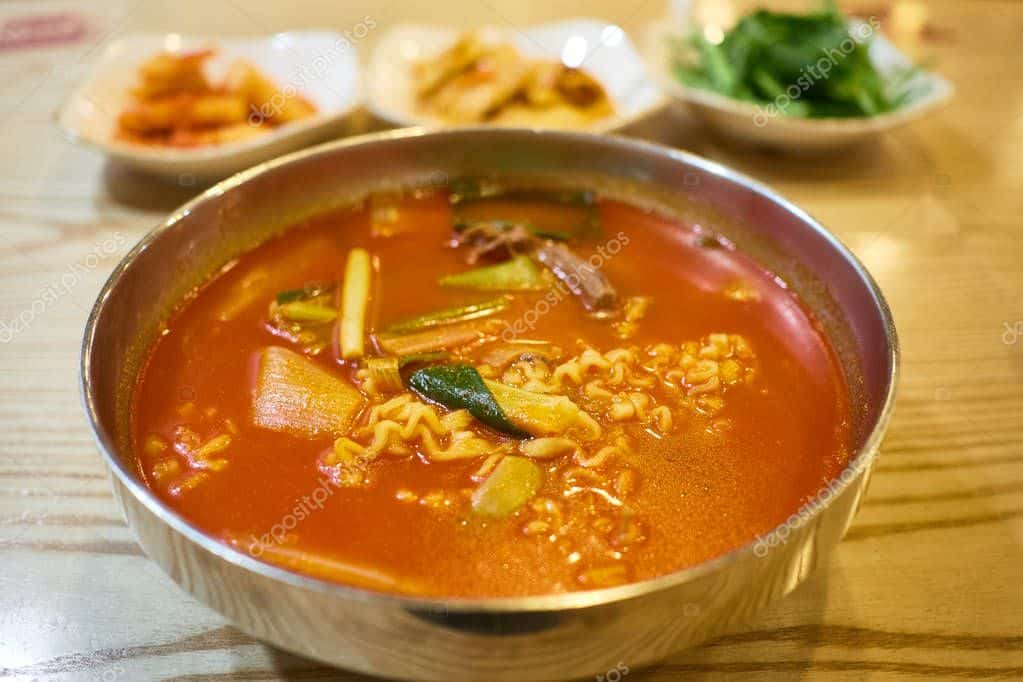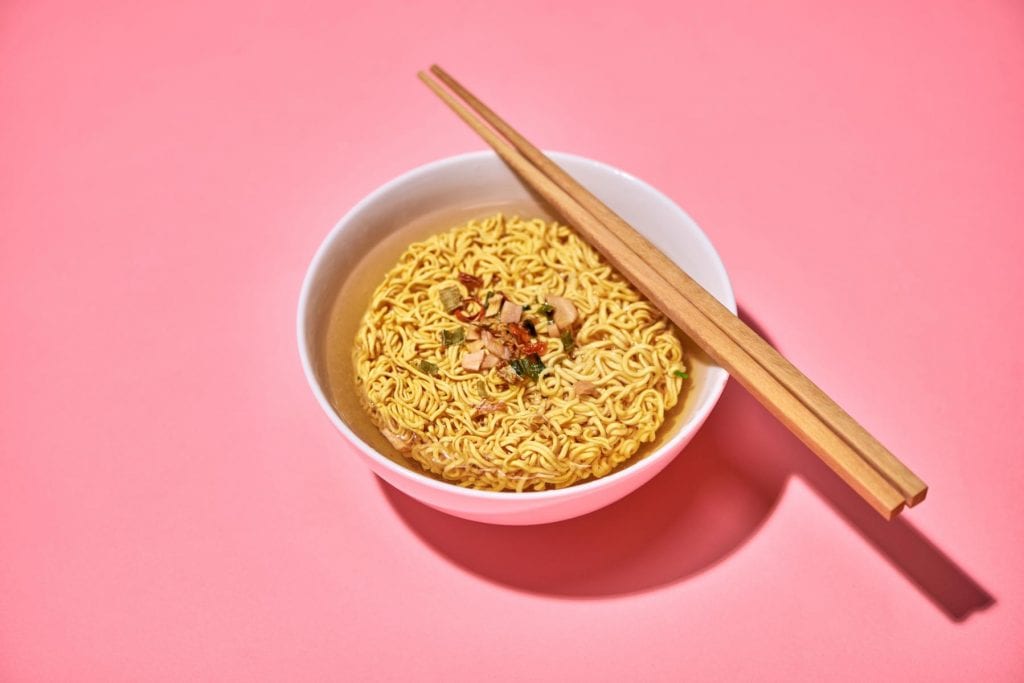All over Asia, noodle soups are absolutely popular. Whether in Japan, China, Vietnam, Thailand, but also in Korea, the noodle soups are slurped in different variations from breakfast to midnight snack.

The origin of all Asian noodle soups is in China. However, noodle soups have spread throughout the continent in no time. From country to country, the noodles and soups were shaped by the typical ingredients and preferences of the country.
In Korea, ramen is also called ramyun. These ramyun are served both in simple cookshops and snack bars, but also in exclusive restaurants.

Instant ramen is at the top of the popularity scale in Korea
Ramyun are the most popular Korean fast food. Ramen is a quick and spicy meal to go that is absolutely loved by all walks of life and all generations. Ramyun noodle soups are always at the top of the list in surveys of favorite dishes.
Yet instant ramen in Korea was born more out of necessity than anything else. In 1963, the Korean War had just ended and the population was poor. Many could barely afford to eat. Therefore, instant ramen became more and more popular. The noodles were cheap, nutritious and you had a proper hot meal in your belly.
Another point in favor of instant ramen was that they can be stored without refrigeration. In addition, the preparation does not require a kitchen. Hot water is enough to create a delicious dish.
Nowadays, every supermarket in Korea, no matter how small, has numerous varieties of instant ramen for sale. Here you just need to pour hot water on it. For this purpose, kettles are available in supermarkets for everyone to take free of charge
Ingredients
Besides the noodles and the different broths or soups, Korean ramen dishes are spiced up with all sorts of other ingredients.
Many ramen soups feature various meats. Whether beef, poultry or pork, the meat is always well marinated, sliced very thinly, fried or steamed and served in the soup.
Further, the Korean ramen soups can be refined with the following ingredients:
- Kimchi
- boiled eggs
- Algae
- Spring onion
- Seafood
- Coriander
- Fish
- Pak Choi
- Ginger raw or pickled
- roasted garlic
- Tofu
- Mushrooms
- Carrots
- Celery
- Kohlrabi
- Seitan
- Tempeh
- Corn and much more
Preparation
The simplest Korean ramen soups are the instant ready-made soups, which are sold in small square packets for small money. Even in this country, these are already available in many Asia markets or online. These packages contain different noodles with various spice mixtures.
Put the pasta in a bowl. Seasoning is done with the included spice sachets. Now pour hot water over the noodles. After about two minutes, the meal is also ready. Quasi stir and enjoy. These ready-made soups come in several 100 flavors ranging from mild to very spicy.
But another method of preparation is also not very laborious. Prepare the ramen noodles according to package directions. Most often, these need to be briefly placed in boiling water. After a few minutes, these are ready and go into a bowl.
Now drape the ingredients of your choice nicely on the pasta. A half boiled egg, a lightly roasted half pak choi, roasted mushrooms, tofu cubes, seaweed and steamed vegetables are nicely arranged. Now pour boiling hot broth over everything and sprinkle with plenty of cilantro, roasted garlic and roasted, coarsely chopped peanuts.
Korean instant ramen

On average, each Korean eats one instant ramen dish per day.
These instant ramen are available in multi-faceted flavors. From vegetarian with vegetables to fish and seafood to chicken, duck, pork and beef, all nuances are represented here.
There are also enormous differences in intensity. Some varieties are enormously mild, but others are very spicy. In Korea, the very spicy varieties are preferred, while in Europe, the mild varieties are more commonly consumed.
Very popular are Korean instant ramen from the brand Nong Shim. From this brand there are also the traditional Kimchi Ramen, which have the typical, Korean Kimchi taste. These instant noodles taste very intense and distinctive of the fermented cabbage, which is an absolute must in Korea.
There are also very popular instant ramen from the Ottogi brand. These are on the market under the name Jin Ramen. These are available mild and spicy and can be refined with many ingredients.
Champong are also sought-after Korean instant ramen soups. These taste very strong and are usually based on fish and seafood. These are also from the company Nong Shim in the assortment.
Neoguri are also Korean fish and seafood ramen. Neoguri ramen differ from other instant noodles that these noodles are slightly thicker. Koreans love these noodles because they are a bit more bite size and have a more distinctive texture.
Buldak Bokkeum Myeon are perhaps the spiciest Korean instant ramen.
Instant ramen is usually packaged in square foil, or in plastic cups. The variant with the plastic cups are very practical. Here you just need to pour the water to the brim and a few minutes later you can start enjoying.
Korean ramen – differences from Japanese ramen
The biggest difference is in the aroma. In general, Korean ramen soups are many times spicier and especially significantly spicier.
Japanese ramen soups are prepared with broths cooked in a soy-based, miso-based or meat-based way. Korean broths, however, are even more strongly seasoned, sometimes even over-seasoned, when viewed with the European palate.
In addition, Korean ramen noodles are also usually thicker. Korean ramen noodles can be broadly compared to thick spaghetti in terms of texture and bite. While Japanese ramen noodles are thin, flat or round, Korean noodles are always slightly thicker.
Recipe differences
In the recipe, Korean ramen noodles differ in the use of many spices. For Korean ramen soups, many seasoning pastes or sauces are also used for refinement. As a result, Korean soups are often bright red or deep black in the bowl.
Dressing differences
In general, there is not too much difference here between Japanese ramen noodles and other noodle soups from Asia.
The ramen noodles are served in soup bowls. The various side dishes and toppings are arranged on top of the noodles and hot soup or broth is poured over everything.
In Korea, as in all other countries, ramen noodles are eaten with chopsticks and a spoon. Use the chopsticks to scoop the noodles into your mouth and slurp. The spoon is then used to spoon the broth. However, this can also be drunk directly from the bowl.
Eating ramen noodles with a knife and fork is an absolute no-go. However, if you are in Korea as a tourist and are not at all comfortable with chopsticks, you will certainly be provided with a fork. However, the long noodles are never cut with a knife. They are slurped whole, or bitten off at most.







